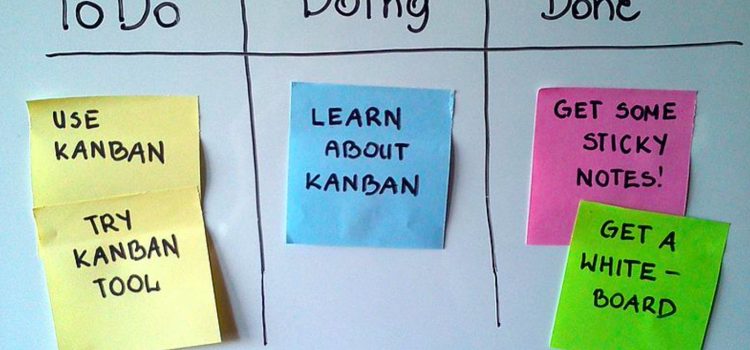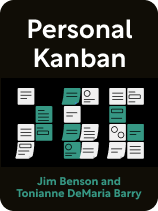

This article is an excerpt from the Shortform book guide to "Personal Kanban" by Jim Benson and Tonianne DeMaria Barry. Shortform has the world's best summaries and analyses of books you should be reading.
Like this article? Sign up for a free trial here.
What is the kanban system? How does having your own personal kanban improve productivity?
Before you start developing your own personal kanban, it’s helpful to understand the system’s background. In Personal Kanban, Jim Benson and Tonianne DeMaria explore what kanban is, its origins and benefits, and the difference between traditional and personal kanban.
Let’s break down the basics of the kanban system below.
What Is Kanban?
What is the kanban system? Kanban is a visual tool for keeping track of tasks as they move through your workflow. The authors explain that, in its most rudimentary version, kanban is a chart divided into three sections laid out as columns: to do, doing, and done. All tasks (usually written on individual sticky notes) begin in the “to do” section, move to “doing” once you’ve begun working on them, and eventually make their way to “done”.
History of Kanban
Kanban originated in Japanese manufacturing. In an effort to reduce mistakes and waste, manufacturing companies implemented lean manufacturing, a management philosophy that argues that all work should be visible to everyone so that every worker is empowered to keep things moving forward and to bring attention to problems or mistakes.
The authors explain that Taiichi Ohno, an engineer at Toyota in the 1940s, came up with kanban as a way to empower line workers to take ownership of the finished product, not just the part they were working on. Ohno believed that they could increase productivity and reduce waste if all workers could visualize the entire process, understand how their work contributed to it, and raise the alarm if they spotted a problem—even if it wasn’t their problem.
By implementing kanbans, according to Benson and DeMaria, Toyota was able to overhaul its production system and massively improve its efficiency by respecting line workers enough to share information with them and give them a voice in the process.
Benson discovered kanban when he worked in software development, where it helped him and his team track their tasks as they progressed through their workflow. The visual and low-effort nature of kanban made collaboration easier because everyone could see what work was being done, what was coming down the pipeline, and where the bottlenecks were.
Benefits of Kanban
Benson and DeMaria argue that kanban offers benefits that other productivity tools can’t. These benefits include transparency, prioritization, and adaptability.
It Reveals Patterns in Your Workflow
A personal kanban board houses all of your tasks, no matter the size, importance, or type. Once you start paying attention to your patterns, it also shows you at a glance where your bottlenecks are, the tasks you’re struggling with, the tasks you’re procrastinating on, how much more you’re able to take on, and many more insights into your work.
The visual and kinesthetic nature of a kanban board makes the information on it more digestible than other planning tools. The physical movement of dragging a task along your workflow, and the mental exercise of putting all of your tasks in one single board helps you understand the life cycle of your work, your limitations, and your priorities. This gives you insight into ways you can improve your efficiency and effectiveness.
It Tells You the Truth
Since everything is out in the open, it’s impossible to hide from your kanban. It will make your limitations obvious because, for example, you’ll quickly realize that you can only accomplish X number of tasks on a given day, week, or month. The authors advise that you lean into this and make sure that you limit how many tasks are in your “Doing” column to a number that you’re confident you can accomplish.
It’s Nudges You in the Right Direction
Personal kanban helps you see all of your options before deciding what to work on. Having all of your tasks in one place, from walking the dog to preparing for a meeting, helps you identify the right task to focus on now, making sure your energy is going where it will have the most impact. By forcing you to limit the tasks you’re working on at any given time, you ensure you’re focusing on priorities you can accomplish.
It’s Adaptable
Personal kanban can adapt to your personal needs in several ways:
- Instead of spending hours making detailed plans that get derailed more often than not, kanban allows you to plan in broad strokes, make progress, and adjust your next steps as you move forward rather than holding on to a plan that isn’t working.
- Personal kanban can hold an ever-growing list of disparate tasks without overwhelming the system. You simply add another sticky note to your backlog.
- You can easily modify the basic system to suit your needs, such as by adding categories or task types that make sense for your work.
Bonus: It’s Better Than a Checklist
The authors argue that to-do lists have many drawbacks that kanban addresses, starting with the mechanics of each. While to-do lists simply list tasks until you check them off, kanban displays your tasks’ entire life cycle, including when they are in progress. A to-do list doesn’t give you information about what you’re currently working on, and its linear display doesn’t differentiate between tasks that are coming up in the future versus those you should be focusing on right now. The authors also argue that to-do lists encourage you to feverishly go from one task to the next without giving you kanban’s fuller picture of what you’ve accomplished and what you have coming up.

———End of Preview———
Like what you just read? Read the rest of the world's best book summary and analysis of Jim Benson and Tonianne DeMaria Barry's "Personal Kanban" at Shortform.
Here's what you'll find in our full Personal Kanban summary:
- Why life is too complex to organize with a to-do list or productivity system
- What a personal kanban is and how it's used by automakers and engineers
- How a visual board helps you see your workflow and make future plans






